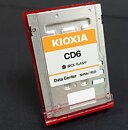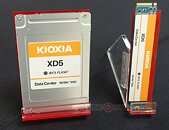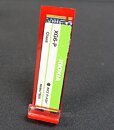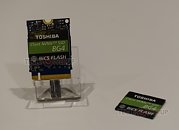Apr 1st, 2025 02:36 EDT
change timezone
Latest GPU Drivers
New Forum Posts
- Build complete! Any thoughts on undervolting? (20)
- Case fans work but can’t sync w/ rgb and stuck full rpm (1)
- Your PC ATM (35317)
- Undervolt i9-14900HX Laptop Newbie (8)
- Help with System Recommendations (5)
- can i yust connect 4 pin cpu coler to 5 pin ? (9)
- PCB serial number explanation Asrock rx5700xt Taichi oc+ (7)
- Post your JetStream 2 speeds! (161)
- Msi Vector 16HX Undervolt (3)
- Bios Mod for an old pc (15)
Popular Reviews
- Sapphire Radeon RX 9070 XT Pulse Review
- DDR5 CUDIMM Explained & Benched - The New Memory Standard
- ASRock Phantom Gaming B850 Riptide Wi-Fi Review - Amazing Price/Performance
- Palit GeForce RTX 5070 GamingPro OC Review
- SilverStone Lucid 04 Review
- Samsung 9100 Pro 2 TB Review - The Best Gen 5 SSD
- Enermax REVOLUTION D.F. 12 850 W Review
- Sapphire Radeon RX 9070 XT Nitro+ Review - Beating NVIDIA
- Assassin's Creed Shadows Performance Benchmark Review - 30 GPUs Compared
- AMD Ryzen 7 9800X3D Review - The Best Gaming Processor
Controversial News Posts
- MSI Doesn't Plan Radeon RX 9000 Series GPUs, Skips AMD RDNA 4 Generation Entirely (142)
- Microsoft Introduces Copilot for Gaming (124)
- AMD Radeon RX 9070 XT Reportedly Outperforms RTX 5080 Through Undervolting (119)
- NVIDIA Reportedly Prepares GeForce RTX 5060 and RTX 5060 Ti Unveil Tomorrow (115)
- Over 200,000 Sold Radeon RX 9070 and RX 9070 XT GPUs? AMD Says No Number was Given (100)
- NVIDIA GeForce RTX 5050, RTX 5060, and RTX 5060 Ti Specifications Leak (96)
- Retailers Anticipate Increased Radeon RX 9070 Series Prices, After Initial Shipments of "MSRP" Models (90)
- China Develops Domestic EUV Tool, ASML Monopoly in Trouble (88)
News Posts matching #BiCS Flash
Return to Keyword Browsing
Kioxia at 2025 CES: 218-layer 3D NAND Flash and UFS 4.0 for Automotive Applications
Kioxia had a small dugout at the 2025 International CES. The NAND flash major tends to have a much bigger booth at FMS than CES. The one in Vegas had its latest enterprise SSDs, all of which were launched through 2024, and a couple of new things. We first got a practical demo of how Kioxia achieves 218 layers of NAND flash in its latest generation of BiCS Flash using an architectural innovation called CBA—CMOS directly bonded to array. In CBA, the cell array acts like a pizza topping to the crust that is the CMOS layer, rather than being arranged side-by-side. This allows for greater density of flash cells. This also has certain performance and power advantages.
Next up, the company showed us their automotive-grade UFS 4.0 non-volatile storage device, which uses the latest 218-layer 3D NAND flash memory. This device was announced toward the end of 2024, and gathered a salad of certifications that make it fit for the latest generation of automobiles with advanced technology such as FSD, or an infotainment system that's practically as powerful as a PC. We also got a fascinating look at the testbed Kioxia uses to validate its automotive UFS 4.0 devices.
Next up, the company showed us their automotive-grade UFS 4.0 non-volatile storage device, which uses the latest 218-layer 3D NAND flash memory. This device was announced toward the end of 2024, and gathered a salad of certifications that make it fit for the latest generation of automobiles with advanced technology such as FSD, or an infotainment system that's practically as powerful as a PC. We also got a fascinating look at the testbed Kioxia uses to validate its automotive UFS 4.0 devices.

KIOXIA Readies the XG7 Client NVMe SSD Leveraging PCIe Gen 4
KIOXIA is readying its next-generation flagship client-segment SSD, the XG7. Some details of the drive surfaced on the UNH NVMe Integrator's List and dug out by Komachi Ensaka. We know the drive's form-factor from the fact that the company's XG6 is a client-segment drive in the M.2-2280 form-factor, which leverages PCIe Gen 3. The XG7 is described as utilizing PCIe Gen 4 and the NVMe 1.4 protocol. No other details were revealed. The drive could utilize the company's latest generation BiCS Flash memory. There's no word on date of announcement of the drive by the company.

Kioxia, Formerly Toshiba Memory, Makes its CES Debut
One of the big hardware industry changes of 2019 was the formal spin-off of Toshiba Memory as an entirely independent firm called Kioxia. This is big, because Toshiba is regarded as the inventor of NAND flash as we know it; and a pioneering firm with DRAM, NAND flash, and other forms of solid-state storage. Toshiba retains the hard disk business. Having formally begun operations only in Q4-2019, much of Kioxia's upcoming products are in development, but we still caught some of their latest SSDs that implement PCIe gen 4.0 and NVMe 1.4 protocol, besides some former-Toshiba products under new Kioxia branding. Kioxia is planning to make a big splash in the near future as its pioneering Twin BiCS Flash tech hits the market, besides scoring design wins with the automotive and data-center industries.
The CD6 and CM6 SSDs are star-attractions. The CD6 is designed for data-centers, and comes in capacities ranging all the way from 800 GB to 15 TB, with 1 to 3 DWPD endurance. It uses the next-generation U.3 (SFF-TA-1001) connector with PCI-Express 4.0 x4 physical-layer and NVMe 1.4 protocol. Among its security features are SIE, FIPS140-2, and SED Opal/Ruby. The drive is built in the 15 mm-thick 2.5-inch form-factor. The CM6 is its cousin, targeted at enterprise environments with higher mission-criticality. With capacities ranging from 800 GB to a staggering 30 TB, the drive offers sequential transfer-rates of up to 6,400 MB/s by leveraging PCI-Express 4.0 x4 and NVMe 1.4. Much like the CD6, the CM6 uses the new U.3 connector, and is built in the 15 mm form-factor. Endurance and security feature-set are identical to the CD6. We also spotted the 2+ year old rebranded XD5-series and PM5-series in fresh Kioxia colors. Lastly, there are the XG6 and XG6-P SSDs from 2019 transitioned to the Kioxia brand.
The CD6 and CM6 SSDs are star-attractions. The CD6 is designed for data-centers, and comes in capacities ranging all the way from 800 GB to 15 TB, with 1 to 3 DWPD endurance. It uses the next-generation U.3 (SFF-TA-1001) connector with PCI-Express 4.0 x4 physical-layer and NVMe 1.4 protocol. Among its security features are SIE, FIPS140-2, and SED Opal/Ruby. The drive is built in the 15 mm-thick 2.5-inch form-factor. The CM6 is its cousin, targeted at enterprise environments with higher mission-criticality. With capacities ranging from 800 GB to a staggering 30 TB, the drive offers sequential transfer-rates of up to 6,400 MB/s by leveraging PCI-Express 4.0 x4 and NVMe 1.4. Much like the CD6, the CM6 uses the new U.3 connector, and is built in the 15 mm form-factor. Endurance and security feature-set are identical to the CD6. We also spotted the 2+ year old rebranded XD5-series and PM5-series in fresh Kioxia colors. Lastly, there are the XG6 and XG6-P SSDs from 2019 transitioned to the Kioxia brand.

Toshiba Unveils BiCS Flash Based e-MMC Ver. 5.1 Devices
Toshiba Memory America, Inc. (TMA), the U.S.-based subsidiary of Toshiba Memory Corporation, today announced that it will begin sampling new JEDEC e-MMC Ver. 5.1 compliant embedded flash memory products for consumer applications next month. The new products integrate the company's BiCS FLASH 3D flash memory and a controller in a single package. The company will continue to reinforce its market-leading position by delivering a broad, high-performance product lineup, including for applications that continue to need e-MMC as an embedded memory solution.

Toshiba Shows Off 96-Layer BiCS FLASH Alongside Plethora of Enterprise SSDs at CES 2019
During our visit with Toshiba at CES 2019, we were shown not only new technologies that they will be rapidly deploying but a large number of SSDs for various market segments. The biggest draw was their 96-layer BiCS Flash with 4-bit-per-cell quadruple-level cell (QLC) technology. Toshiba is now pushing the boundary for capacity as a single chip device can reach 1.33 Tb (Terabits) while a single package device with 16-dies stacked architecture can reach 2.66 TB. That said, they are already sampling their 1 TB NVMe single package BG4 series SSDs to PC OEM customers in limited quantities.
These latest drives with their new BiCS FLASH technology incorporate everything into a tiny SSD that offers class-leading storage with sequential read performance reaching up to 2250 MB/s. Random read performance can also hit exceptional levels reaching up to 380,000 IOPS. For now, these BG4 based drives are targeted at ultra-thin PC notebooks, IoT embedded systems and will be made available in four capacities including; 128 GB, 256 GB, 512 GB and finally 1 TB. To meet expected demand, Toshiba will also be opening a facility in Japan dedicated to this latest technology in order to bring even higher capacities per NAND module.
These latest drives with their new BiCS FLASH technology incorporate everything into a tiny SSD that offers class-leading storage with sequential read performance reaching up to 2250 MB/s. Random read performance can also hit exceptional levels reaching up to 380,000 IOPS. For now, these BG4 based drives are targeted at ultra-thin PC notebooks, IoT embedded systems and will be made available in four capacities including; 128 GB, 256 GB, 512 GB and finally 1 TB. To meet expected demand, Toshiba will also be opening a facility in Japan dedicated to this latest technology in order to bring even higher capacities per NAND module.

Toshiba Breaks Ground on Biggest, Most Advanced BiCS FLASH Fabrication Facility in Kitakami City, Japan
Toshiba Memory Corporation, the world leader in memory solutions, today held a groundbreaking ceremony for the first semiconductor fabrication facility (fab), called K1, in Kitakami, Iwate prefecture, in northeastern Japan. On its completion in autumn 2019, the facility will be one of the most advanced manufacturing operations in the world, dedicated to production of 3D flash memory.
Toshiba Memory continues to advance technologies in flash memory. The company is now leading the way forward with advances in its BiCS FLASH , its proprietary 3D flash memory.
Toshiba Memory continues to advance technologies in flash memory. The company is now leading the way forward with advances in its BiCS FLASH , its proprietary 3D flash memory.

Toshiba Adds New Lineup of Data Center SSDs Featuring 64-layer BiCS Flash
Toshiba Memory America, Inc. (TMA), the U.S.-based subsidiary of Toshiba Memory Corporation, has enhanced its portfolio of solid-state drives (SSDs) for the data center with a new, 3D flash memory-based lineup of PCI Express NVMe and SATA SSDs in multiple form factors. The new CD5, XD5 and HK6-DC SSDs enable infrastructure managers to address performance and workload demands by offering robust performance and reliability with lower operating power for read-intensive applications such as NoSQL databases, big data analytics and streaming media.
"Demand for flash storage in data centers continues to grow rapidly - with capacity shipped into the enterprise expected to increase at a 58 percent CAGR through 2021," said Jeff Janukowicz, IDC Research Vice President for Solid State Drives and Enabling Technologies. "In order for hyperscale, virtualization, automation/orchestration and software-defined storage applications to thrive, cloud data centers must meet specific workload requirements. Toshiba's latest data center SSDs are designed to help customers address these demanding environments and realize the most value from their flash storage."
"Demand for flash storage in data centers continues to grow rapidly - with capacity shipped into the enterprise expected to increase at a 58 percent CAGR through 2021," said Jeff Janukowicz, IDC Research Vice President for Solid State Drives and Enabling Technologies. "In order for hyperscale, virtualization, automation/orchestration and software-defined storage applications to thrive, cloud data centers must meet specific workload requirements. Toshiba's latest data center SSDs are designed to help customers address these demanding environments and realize the most value from their flash storage."

Toshiba's Not-so-flashy CES Booth was Full of Flash
Toshiba throughout 2017 made big moves in the flash storage industry, particularly its bitter falling out with WD/SanDisk. The company today is more innovative than ever. Its 2018 International CES booth had a mix of products by the original Toshiba digital storage products division, and its client-focused, US-based, former OCZ division. The star-attraction isn't some big PCIe add-on card SSD that can push a dozen terabytes per second; but the modest RC100 M.2 NVMe drive. Drives like it could make NVMe storage affordable for upper-mainstream gaming PC builders throughout 2018.
The RC100 has been exhaustively detailed in one of our older articles. It's an M.2-2242 drive with PCIe gen 3.0 x2 interface, and more than triple the transfer rates of the fastest SATA SSD you can find. This drive will be gulped down by both the DIY and OEM markets. Next up, is the TR200 entry-level SATA SSD launched last October, targeted at those still clinging onto HDDs or first-time builders. It features Toshiba's 64-layer TLC NAND flash to achieve some of the lowest price-per-gigabyte ratios.
The RC100 has been exhaustively detailed in one of our older articles. It's an M.2-2242 drive with PCIe gen 3.0 x2 interface, and more than triple the transfer rates of the fastest SATA SSD you can find. This drive will be gulped down by both the DIY and OEM markets. Next up, is the TR200 entry-level SATA SSD launched last October, targeted at those still clinging onto HDDs or first-time builders. It features Toshiba's 64-layer TLC NAND flash to achieve some of the lowest price-per-gigabyte ratios.

Toshiba RC100 "Entry-level" M.2 NVMe SSD Detailed Some More
Following its early-CES launch, we have more details of Toshiba's "entry-level" M.2 NVMe SSD, the RC100. This drive is designed to offer significantly higher performance than SATA SSDs, at a tiny (10-15 percent) price premium over the fastest SATA SSDs. This market has been made inroads to by companies like ADATA, with their XPG SX6000-series. The RC100, offers not only NVMe performance, but also a more compact size. The drive is built in the M.2-2242 form-factor (42 mm long). It will fit on any motherboard that supports M.2-2280 drives, you just have to move the fastening nut to an inner hole marked "42."
Toshiba RC100 drives combine an in-house developed controller with Toshiba 64-layer BiCS Flash TLC memory. The drive features PCI-Express 3.0 x2 host interface, and takes advantage of the NVMe 1.2 protocol. It offers sequential transfer rates of up to 1,620 MB/s reads, with up to 1,130 MB/s writes; and 4K random access performance of up to 160,000 IOPS reads, and 120,000 IOPS writes. The drive comes in capacities of 120 GB, 240 GB, and 480 GB, and is backed by a 3-year warranty.
Toshiba RC100 drives combine an in-house developed controller with Toshiba 64-layer BiCS Flash TLC memory. The drive features PCI-Express 3.0 x2 host interface, and takes advantage of the NVMe 1.2 protocol. It offers sequential transfer rates of up to 1,620 MB/s reads, with up to 1,130 MB/s writes; and 4K random access performance of up to 160,000 IOPS reads, and 120,000 IOPS writes. The drive comes in capacities of 120 GB, 240 GB, and 480 GB, and is backed by a 3-year warranty.

Toshiba to Prepare New Semiconductor Fabrication Facility in ¥7b Investment
Toshiba Corporation today announced that it is going ahead with a forward-looking plan for a new memory fabrication facility in Kitakami, Iwate prefecture. Toshiba Memory Corporation (TMC), a wholly owned subsidiary of Toshiba, will establish a company to operate the facility, and invest approximately 7 billion yen in site preparation and initial construction work in FY2017. The new facility, announced on September 6, 2017, will produce BiCS Flash, TMC's proprietary flash memory. It will be TMC's seventh fab.

Toshiba Unveils the XG 5 M.2 Performance NVMe SSD
Toshiba today unveiled the XG 5 series performance-segment SSDs in the M.2-2280 form-factor. These drives take advantage of the PCI-Express 3.0 x4 interface, and the NVMe 1.2 protocol. At the heart of these drives is Toshiba's 64-layer BiCS Flash (3D TLC NAND flash) memory. Available in capacities of 256 GB, 512 GB, and 1 TB, the drive offers sequential transfer speeds of up to 3,000 MB/s reads, with up to 2,100 MB/s writes. The drive features an SLC-cache feature, in which the drive treats a small portion of the TLC NAND flash as SLC NAND, by storing just 1 bit per cell, hot data is juggled in and out of this portion. The drives will go on sale in the first week of June.

Toshiba BG Series M.2 NVMe SSDs are Really Small
Toshiba showed off its new BG Series M.2 SSDs, which will grab your attention for being quite small. Measuring 16 mm x 20 mm, these drives are shorter than the shortest (30 mm) M.2 length standard. They still take advantage of the PCI-Express 3.0 x2 interface, and the NVMe protocol. At the heart of this drive is Toshiba's BiCS Flash, a multi-chip module that combines stacked TLC NAND flash memory with an SSD controller into one package. The drives come in capacities of 128 GB, 256 GB, and 512 GB. Toshiba is also separately selling these drives as chip-only, to notebook manufacturers, so they can solder them directly onto the mainboards of their low-cost ultra-portable notebooks.

Toshiba Announces New BG SSDs with 3-Bit-Per-Cell (TLC) BiCS Flash
Toshiba America Electronic Components, Inc. (TAEC), a committed technology leader, will showcase its new BG series solid state drive (SSD) family featuring cutting-edge BiCS FLASH with 3-bit-per-cell TLC (triple-level cell) technology and Toshiba's new single-package ball grid array (BGA) NVMe PCI Express (PCIe) Gen3 x2 SSD at the 2016 Flash Memory Summit held in Santa Clara, California between August 8 - 11. Delivering a smaller footprint, lower power consumption and better performance than traditional storage options, the BG SSD series is purpose-built for the future wave of ultra-thin mobile PCs, including 2-in-1 convertible notebooks and tablets.
With a surface area 95 percent smaller than conventional 2.5-inch SATA storage devices and 82 percent smaller than M.2 Type 22806, the Toshiba BG series condenses both the controller and NAND flash memory in a single 16 mm x 20 mm BGA package enabling device manufacturers to prioritize features like battery capacity for longer operating times. The BG series is also available mounted on a M.2 Type 22307 module for applications requiring socketed storage. BG SSDs utilize BiCS FLASH, a three-dimensional (3D) stacked cell structure, making it possible to accommodate up to 512 GB of storage capacity in this high-performance and compact form factor. Additionally, the BG series SSDs utilize an in-house Toshiba-developed controller and firmware for a full, vertically developed solution, ensuring technology is tightly integrated for optimal performance, power consumption and reliability.
With a surface area 95 percent smaller than conventional 2.5-inch SATA storage devices and 82 percent smaller than M.2 Type 22806, the Toshiba BG series condenses both the controller and NAND flash memory in a single 16 mm x 20 mm BGA package enabling device manufacturers to prioritize features like battery capacity for longer operating times. The BG series is also available mounted on a M.2 Type 22307 module for applications requiring socketed storage. BG SSDs utilize BiCS FLASH, a three-dimensional (3D) stacked cell structure, making it possible to accommodate up to 512 GB of storage capacity in this high-performance and compact form factor. Additionally, the BG series SSDs utilize an in-house Toshiba-developed controller and firmware for a full, vertically developed solution, ensuring technology is tightly integrated for optimal performance, power consumption and reliability.
Apr 1st, 2025 02:36 EDT
change timezone
Latest GPU Drivers
New Forum Posts
- Build complete! Any thoughts on undervolting? (20)
- Case fans work but can’t sync w/ rgb and stuck full rpm (1)
- Your PC ATM (35317)
- Undervolt i9-14900HX Laptop Newbie (8)
- Help with System Recommendations (5)
- can i yust connect 4 pin cpu coler to 5 pin ? (9)
- PCB serial number explanation Asrock rx5700xt Taichi oc+ (7)
- Post your JetStream 2 speeds! (161)
- Msi Vector 16HX Undervolt (3)
- Bios Mod for an old pc (15)
Popular Reviews
- Sapphire Radeon RX 9070 XT Pulse Review
- DDR5 CUDIMM Explained & Benched - The New Memory Standard
- ASRock Phantom Gaming B850 Riptide Wi-Fi Review - Amazing Price/Performance
- Palit GeForce RTX 5070 GamingPro OC Review
- SilverStone Lucid 04 Review
- Samsung 9100 Pro 2 TB Review - The Best Gen 5 SSD
- Enermax REVOLUTION D.F. 12 850 W Review
- Sapphire Radeon RX 9070 XT Nitro+ Review - Beating NVIDIA
- Assassin's Creed Shadows Performance Benchmark Review - 30 GPUs Compared
- AMD Ryzen 7 9800X3D Review - The Best Gaming Processor
Controversial News Posts
- MSI Doesn't Plan Radeon RX 9000 Series GPUs, Skips AMD RDNA 4 Generation Entirely (142)
- Microsoft Introduces Copilot for Gaming (124)
- AMD Radeon RX 9070 XT Reportedly Outperforms RTX 5080 Through Undervolting (119)
- NVIDIA Reportedly Prepares GeForce RTX 5060 and RTX 5060 Ti Unveil Tomorrow (115)
- Over 200,000 Sold Radeon RX 9070 and RX 9070 XT GPUs? AMD Says No Number was Given (100)
- NVIDIA GeForce RTX 5050, RTX 5060, and RTX 5060 Ti Specifications Leak (96)
- Retailers Anticipate Increased Radeon RX 9070 Series Prices, After Initial Shipments of "MSRP" Models (90)
- China Develops Domestic EUV Tool, ASML Monopoly in Trouble (88)



























